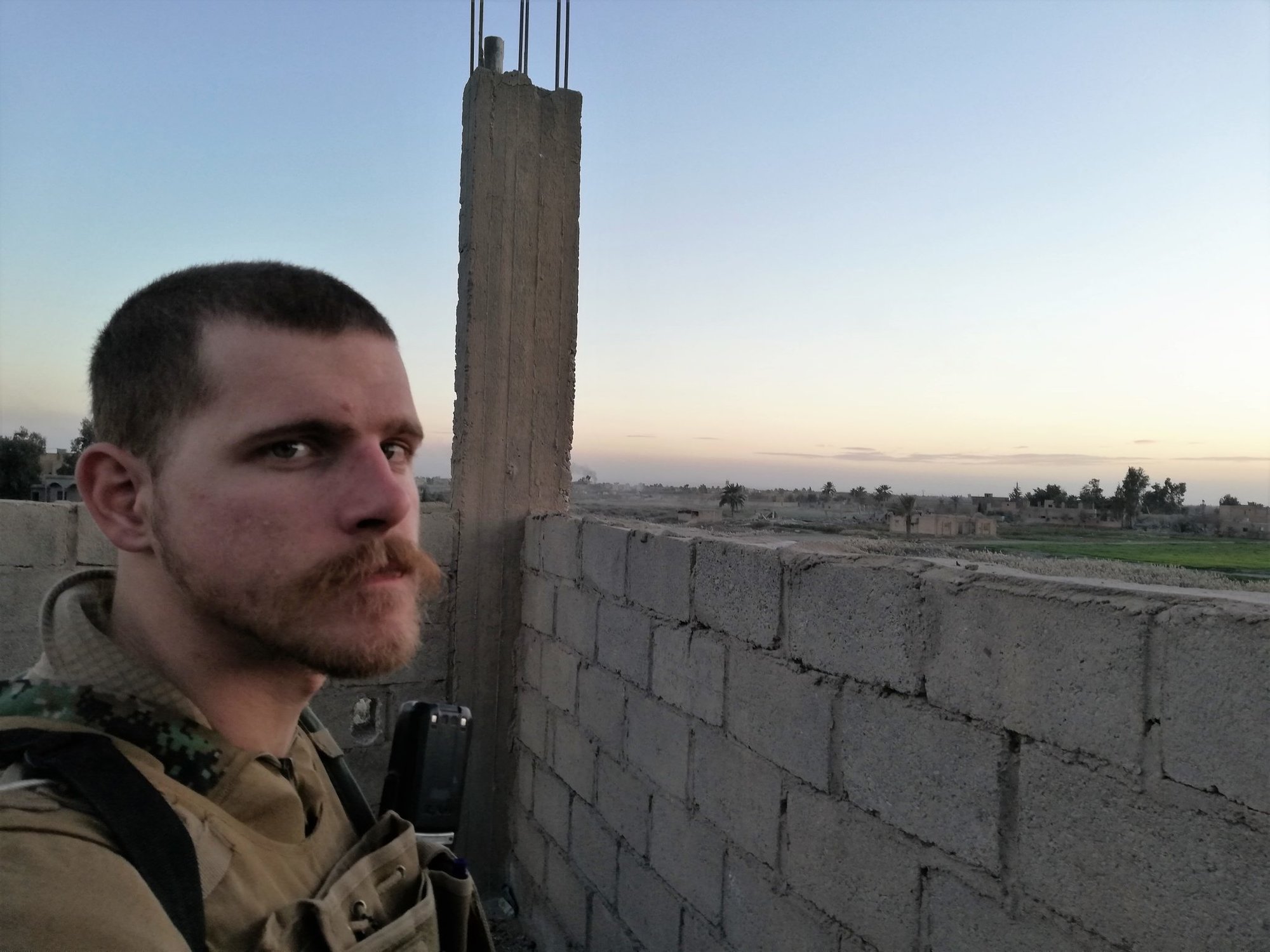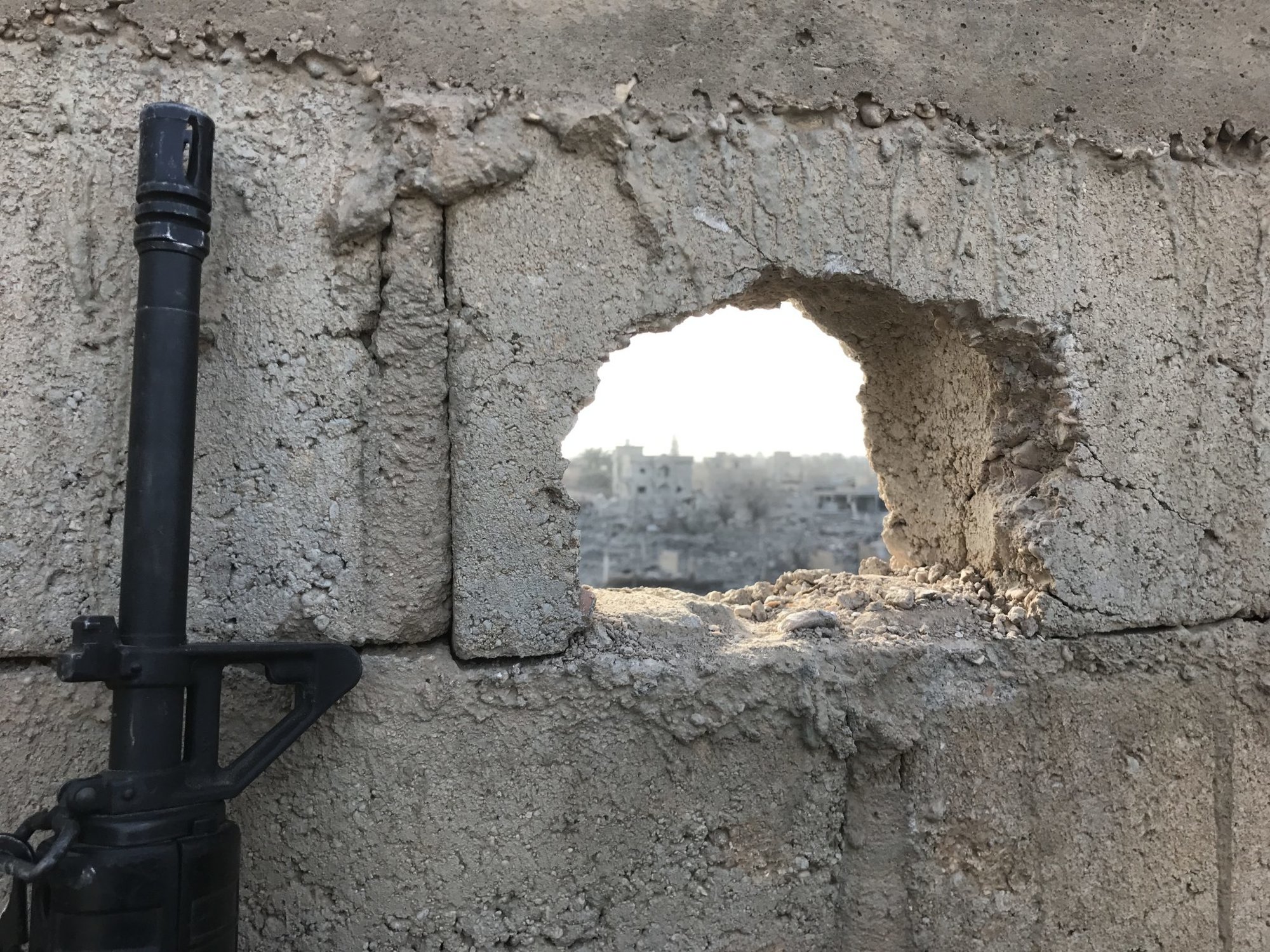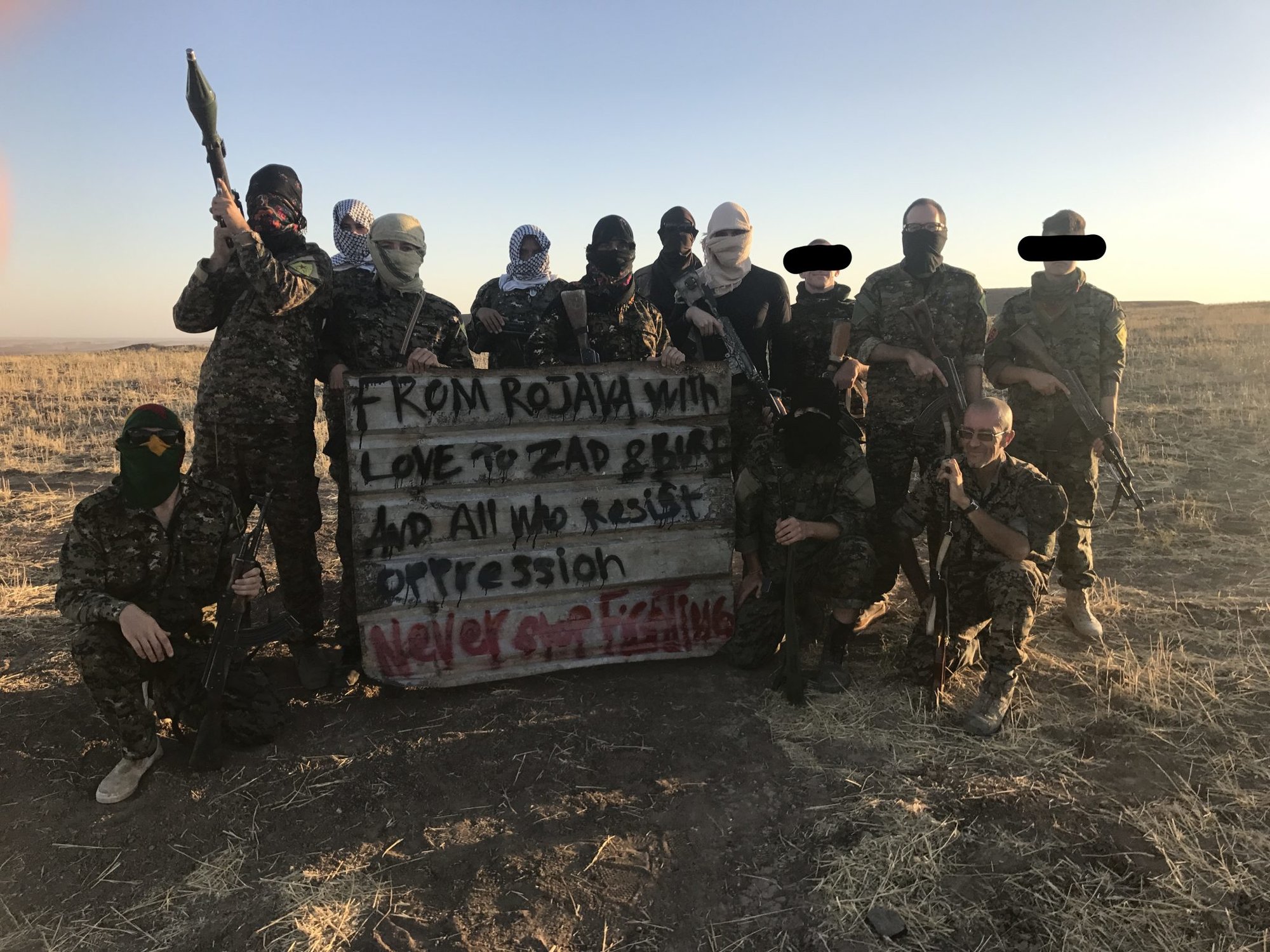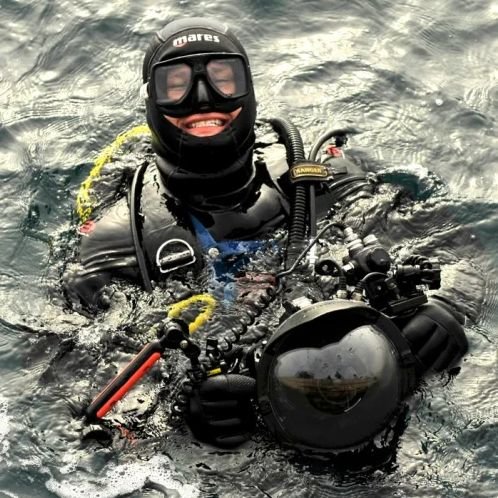
Much of the first months Stoddard spent in Rojava were spent doing nothing. Boredom was rampant. Any semblance of military action came in the form of guard duty. Photo courtesy of Warren Stoddard II.
Watching from the roof of a makeshift command post in the Syrian town of Hajin, the Texan surveyed the no man’s land of hollowed-out, bullet-riddled buildings and earth scorched by the fight against ISIS. The ground looked like a pale version of what it once was.
He loosened the kaffiyeh from around his mouth and took a drag of a cigarette.
A clear afternoon morphed into an ominous scene as black smoke and sand filled the blue sky. The smell of burning rubber and gunpowder hung heavy in the air.
Suddenly the air became still, time slowed down, and silence washed over the area.
His body responded with heightened senses, preparing for the unknown. He stared down the barrel of the rifle to the north, where ISIS was holding a position. His body was tense, but the right index finger was loose, lightly kissing the trigger.
“They’re coming,” a voice from behind said, breaking the thick silence.

Warren Stoddard II found himself smack dab in the middle of a fight, precisely where he wanted to be. For the last year, he had been on the Syrian front lines of conflict supporting the People’s Protection Units, or YPG.
In 2011, the YPG was born from the alliance of several Kurdish political parties to defend Kurdish-inhabited areas in northern Syria. Mostly consisting of Kurdish, Arab, and international volunteers, the YPG and sister militia, the Women’s Protection Units, now fight together to eradicate the Islamic State, or ISIS.
Four years later and 7,000 miles away in central Texas, an 18-year-old Stoddard rose his right hand and enlisted in the Marine Corps. This act held special meaning as it began his journey of service, following in the footsteps of his father.
“My dad was Force Recon, a real bad motherfucker,” Stoddard said. “He did everything — jump wings, sniper school, combat dive. All of it.”
Stoddard has only vague memories of his father. He had just three years with him before he was murdered.
“I’ve spent more time looking at his headstone than his face,” Stoddard said. “On his headstone is the Force Recon insignia and the title US Marine underneath his name. I basically wanted to be in the military to get to know my dad, so I enlisted in the Marines the day after my 18th birthday.”
Waivers he had received for knee surgeries were no longer approved. He could not enlist in the Marines.
In April 2014, as Stoddard awaited his all-expenses-paid trip to Parris Island in June, he received news from his recruiter: Waivers he had received for knee surgeries were no longer approved. He could not enlist in the Marines.
“I was fucking crushed, completely devastated,” he said.
Accepting the news but still looking for direction, Stoddard enrolled at Texas State University with the hopes of pursuing his passion for writing. While beginning his undergrad, he was approached by a high school friend and persuaded to join the school’s Army Reserve Officers Training Program.
During his time in ROTC, Stoddard reignited his passion for service and excelled at everything military related. He was a standout in ROTC, excelling as the No. 1 cadet for the school and top five for the region.
“I crushed it; serving in a military type of unit was the one thing in my life that I was ever naturally good at,” he said. “I was really good at military shit, for whatever reason, probably because of how long I just wanted to do it.”
Just as Stoddard was excelling, fate was moving in to deliver another dream-crushing blow. Regardless of his raw talents, the dream of serving in the Army was moving farther out of his reach. This time Stoddard’s hearing tests disqualified him from service.
As one door closed, opportunity presented a different path to serve.
In the summer of 2016, Stoddard learned of Levi Shirley, an American YPG member from Colorado killed fighting ISIS in Syria. The story resonated with Stoddard. He and the Coloradan shared similar paths. Both yearned to serve, and both were not medically qualified for US military service. Stoddard then took the opportunity to reach out via Facebook to the international recruiting arm of the YPG.
After waiting several months, he received no response. For the next two years, Stoddard followed the YPG online and tracked their efforts to defeat ISIS. Eventually, he graduated with a degree in English.
At the beginning of 2018, Stoddard sent another message to the YPG. This time, they replied and granted his request to join the fight. The front lines and a reason to serve were now within reach.
Over a few months, he and his YPG recruiter finalized paperwork, and Stoddard bought a one-way ticket to Iraq, where his first face-to-face meeting would take place.
In Iraq, Stoddard linked up with what he assumed were other fresh recruits. The journey continued north until he reached the Syrian border, where he was smuggled across.
“When I was traveling from Iraq to Syria, Turkey was on an airstrike campaign in northern Iraq,” Stoddard said. “The trip was super sketchy. We were so close to the fighting we could feel the explosions shake the ground as we traveled through the mountains into Syria.”
Stoddard arrived at his YPG boot camp, the “Academy,” in June 2018 but didn’t start training until September. His assimilation began with intense cultural education: the history of the Kurdish people and YPG. For the instructors, the international recruits needed to have a strong understanding of why they were fighting. Academy instructors were teaching compassion and understanding for why they fight and not just employing mercenaries looking to get their war on.

“It was put to me quite simply: You’re not a foreigner anymore. No matter what anybody says, you are one of us. You’re not Kurdish, but you are a Kurd. We don’t want outsiders here. We don’t want foreigners here. We want people who will be a part of this revolution. This is not a thing about nation-states. It’s a thing about humanity.”
At that moment of acceptance and understanding, Stoddard finally found the service he was searching for. He was where he was supposed to be: fighting for what he believed in, his journey now weaved into an international brotherhood of YPG fighters.
Stoddard’s travels through Syria proved enlightening. His presence in the cradle of civilization was not lost as he traveled to the front. The dichotomy amused him. Many Syrians live as farmers — much like people did 2,000 years earlier — while others embrace technology, glued to their phones and social media. These contrasting lifestyles are woven together across the topography of Syria.
Stoddard quickly became an asset to his YPG comrades. His quick assimilation and ROTC experience earned him a position as head of security for his international team. His skills were diverse, and he exploited them to become an asset.
“I was in charge of our base perimeter — a driver, a machine gunner — and for most of my tour was part of a squad of designated marksmen,” Stoddard said. “As part of the international unit, I used a variety of weapons, including the Dragunov sniper rifle and an M16 with an ACOG (Advanced Combat Optical Gunsight). I mostly carried a beautiful Russian AK-47.”
His unit’s allotment of weapons were not from a central issue but captured war supplies. The soldier’s responsibility was to outfit himself with whatever proper protective equipment they could find or pull together from other units.
“We only had two rules: Everyone carries three tourniquets, and clean your rifle after you use it,” Stoddard said. “Whatever you want to rock into combat was up to you. You don’t want to wear any body armor at all? That’s on you. You don’t want to wear a helmet? That’s cool. The only requirement was wearing a uniform and the distinctive yellow patch of the YPG.”
In early 2019, Stoddard joined Operation al-Jazeera (Operation Roundup to the coalition). He was positioned along the Euphrates River across the border from Anbar province, Iraq. He and his YPG international team began the final push to Baghouz, advancing by night, establishing positions by day.
Months of anticipation and excitement turned abruptly into awareness and apprehension. An area once teeming with life and culture now showed the scars of combat. YPG units were staged sporadically throughout a defined fighting line, occupying rooftops — an overwatch for a future push forward.
His unit was charged with methodically moving forward, inch by inch, and driving ISIS fighters back. Unlike recent conflicts, this confrontation had traditional battle lines. Enemies squaring off across from each other, force-on-force contact.
“Our fighting was so incredibly different from the ones that you’ll find in Iraq and Afghanistan,” Stoddard said. “I would describe it like World War I trench warfare. We had a designated front line 200 meters in no man’s land, and anything beyond that was the enemy. Whereas most US veterans were fighting insurgencies all the way back to Vietnam. I do not envy that at all. That shit seems so incredibly confusing.”
Stoddard recalls his first night on patrol, learning what to look for and beginning a love-hate relationship with coalition airstrikes.

“I thought to myself, I’ve never been to war. I don’t know what the fuck I’m doing,” Stoddard said. “One night on watch, I saw a flashlight flicker about 300 meters forward from my position, I turned to my buddy Asiti from Arizona.”
“Can I fucking shoot that thing?”
“He’s like, ‘Hell yeah, man, light it up!'”
As soon as Stoddard slung his rifle up to take aim, the scream of diving coalition aircraft unleashed a firestorm of ordnance on the unknown flickering light, permanently extinguishing it.
For the next few weeks, he and his team would move from building to building, methodically clearing each room, floor, and rooftop. YPG units were supported overhead with an unmatched advantage of US and French aircraft. The YPG were generous in calling for air assists against ISIS fighters. These precision strikes were relayed from forward observation posts to a command-and-control element to the rear of Stoddard’s position.
This rear element — composed of international forces, Kurdish ground force commanders, and American Special Forces units — were happy to call those requests in to aircraft circling overhead. They watched as the precision ordnance provided a routine fireworks spectacle.
This wouldn’t be the first or last time Stoddard would interact with American special operations teams. Stoddard says he and other international YPG fighters were noticeably whiter than their Kurd and Arab counterparts.
“You can tell an American when you see him over there, and they (Special Forces) knew we were American,” Stoddard said. “There was no mistaking the [US] team guy trademark: pretty hair, black sunglasses, and clean uniforms. We would always fuck with the guys whenever they were flying over us. The Special Forces guys would fly their helicopters low and rattle the shipping containers we were living in; in return, we would throw oranges at them.”
In early 2019, Stoddard and his team were poised to make a push deeper into the enemy-occupied town of Ash Sha’fah. ISIS and their weapons were up early this day. Sporadic gunfire could be heard as YPG fighters started their morning rooftop fires and making tea.
The content of what was burned in the fire was an omen for how the day would unfold. The days of burning plastic were not as favored as the days where the occupied home contained furniture made of wood. The morning’s fire was provided by an exquisite wooden chair.
Sometime in the middle of the night, small-arms fire woke Stoddard. The radio immediately crackled and requested his team move to the adjacent building. Stoddard peeked through a window and surveyed a route.
The path was barely visible; natural light seemed to avoid the area. The 20 or so meters between buildings took him through a vacant lot with several abandoned cars.

Stoddard thought to himself, Great, I have to walk through this boobytrap field at night.
The new moon provided no ambient light. As the two-man team began moving through the lot, he and his teammate seemed to stumble and trip over every single bar, pipe, and tire. Halfway through, the frustration and anticipation of stepping blindly on a boobytrap outweighed reason and light discipline. Stoddard’s teammate turned on his flashlight.
Quickly navigating the rest of the junkyard, they made it to their new location, lay down, and dumped built-up adrenaline.
Just as Stoddard began to relax, the scream of an aircraft snapped him back to reality.
“There was a big white flash, and the sky fucking ripped apart,” he said. “The bombs hit right where we had been walking, like 20 meters from our position. Bricks came crashing down from the rooftop. The explosion shook me to my bones. Who the hell called an airstrike on me?”
The use of the flashlight seemed to draw the attention of someone with airstrike access. Immediately following the airstrike, YPG commanders yelled frantically in Kurdish over the radios, criticizing the misplaced strike.
For the next few hours, aircraft swarmed the area, diving low and filling the air with the sounds of afterburner thunder. For the rest of the night, coalition aircraft delivered sleep deprivation.
The sun lazily crept above the horizon and provided minor relief from frigid temperatures as the smell of cigarettes and tea permeated the crisp, clean air.
Without sleep and time to process what had happened a few hours ago, his radio crackled a preparatory sound of static, then information. Stoddard got orders to disable a suspected vehicle improvised explosive device (VIED) parked in a garage not far from his position. Intelligence said the van was covering up an underground tunnel ISIS was using to transport explosives.
Stoddard surveyed the landscape. With last night’s journey still fresh in his mind, he analyzed the risk of movement and maneuvered to position. The van was parked in a garage and looked abandoned. Stoddard readied his rifle and disabled the van with well-placed rounds to the tires. With the suspected VIED disabled, he gathered himself and fell back to his temporary post. He badly needed sleep, and as he tried to relax, the January wind picked up.
Stoddard, trying to keep his mind off the action of last night’s close call, settled into another chapter of his Game of Thrones novel. Just as the normalcy of a morning routine took place, mortars began exploding on all sides of the building.
“We were getting mortared by ISIS in the front and allies from the rear,” Stoddard said. “And in the middle is our house.”
As Stoddard reluctantly accepted his position in a mortar shit sandwich and took cover, the air began to thicken from the dust and smoke kicked up by the explosions. The increasing wind did nothing to clear the air as he peered through a second-story window. Maneuvering to the roof, he stayed low and took a fighting position.
Surveying the enemy landscape, the black smoke from burning tires told Stoddard ISIS was preparing for an advance. The smoke hid heat signatures of enemy fighters from any drones circling overhead.
He knew that, but he also knew that anything stupid enough to move in front of him would get shot.
Then the voice broke the tension: “They’re coming.”
“While we were on the rooftop, we were taking more and more sporadic small-arms fire,” Stoddard said. “I don’t know how long we were engaged; I vividly remember these two guys running behind this rubble pile. I fired on both of them and watched them stumble behind a wall. Just then the concrete in front of my face exploded.”
Rattled and disoriented, Stoddard took a moment.

“Oh fuck, that was close,” he blurted.
A moment later, adrenaline slowed, and the feeling came back to his body.
“Oh shit, I can’t feel my leg.”
Stoddard looked behind him for support or confirmation on what just happened. Everyone was gone. He stumbled off the roof to an open stairwell and linked up with a member of his team.
“I think I’m hurt; it feels like I’ve been hit in the back of the leg by a meteor.”
They both began to pat frantically all over Stoddard’s body, feeling for pain and checking for blood.
“I checked myself, and I’m like, ‘I’m fine,’” Stoddard recalled. “I try to walk down the stairs. It feels weird. I looked down at my boot. I see there’s a hole in it, and blood is starting to ooze out of it. I search my back leg again; this time, my hand was covered in blood.”
Stoddard looked at his teammate, saying, “Hey, man, I’m injured,” and showing him his blood-soaked hand.
“Oh, fuck, you’re hurt,” the man replied.
The man helped Stoddard to the bottom floor, where radios frantically chirped for immediate assistance. Time passed slowly, and he noticed the blood continuing to saturate his uniform. Reaching into his medical bag, he desperately searched for his tourniquet. He quickly opened it and fit it snugly around his upper thigh before cranking it down until the blood slowed, then stopped.
After what felt like an eternity, the medical extract Humvee arrived, but at the wrong location. It was parked about a football field away from his position. With his ability to walk compromised, Stoddard’s chances of making it solo to the Humvee alive were not favorable.
Standing just beyond an open doorway, he stared at the Humvee. As fighting continued to rage beyond the door, Stoddard watched and waited for support.
“The Kurdish commander tells me he has a plan; he points to this big hulking Arab and tells me that he’s going to carry me to the Humvee,” Stoddard said. “Without hesitation, the beefy Arab throws me on his back. We stand in the door frame and wait for a break in the incoming mortars.”
With Stoddard slung over the Arab’s shoulders, the men took a deep breath, stepped outside and started running. Everything seemed to explode around them. Gunfire was coming from everywhere. Mortars landed randomly, shrapnel and debris peppering the men as they plowed forward to the Humvee.

As the Arab man threw Stoddard in the back of the Humvee, Stoddard said goodbye just before the man gave him a last look, slammed the door, and sprinted back to the fight.
“He saved my ass that day. I didn’t even get to say thanks,” Stoddard said.
Growling like a diesel dragon, the Humvee lurched forward, weaving through the alleyways and dead ends of the war-torn city.
With adrenaline raging through his body, the anticipation, stress, and uncertainty of what would happen next filled his thoughts. The time on Stoddard’s tourniquet was marked 2:30 p.m. His leg would suffer permanent damage if it were left on longer than two hours.
At a YPG checkpoint, Stoddard was hurried out of the Humvee and placed in the back of a pickup truck. A short time later, he arrived at a medical outpost where he was treated by American Special Forces medical staff until an ambulance arrived to transport him to a larger facility.
The options for Stoddard to depart the medical facility and return back to his unit were limited. His injury was severe enough to warrant a medical evacuation back to a facility in Iraq or even the US, but his status as an American fighting for the YPG but not the US military created a legal gray area. Most options involved time in an Iraqi jail, so he opted to return to his unit.
A high-ranking Kurdish general who was inspired by Stoddard’s sacrifice gave him a ride back to his YPG unit. He took a few weeks to heal up before making the journey over the border into Iraq.
“It was really difficult to leave emotionally,” Stoddard recalled. “I’d been with those guys with no contact with anybody else for over seven months.”
A day after crossing the border, he boarded a flight back to the US. He left the war behind but not the scars. He lives with the memories of his YPG brothers in arms and the mental and physical baggage of a combat veteran.
“My time with the YPG has had the most influence on who I am,” Stoddard said. “War corrodes everyone, and in the aftermath, there are many eaten so badly by the acid of it that they lose sight of themselves or jump back into the vat or succumb to those fresh, acid-born demons. Very few see the light in any of it — humanity is gone to all who have walked those steps and felt the sting of killing. War is terrible, but you fucking love it.”

Jayme Pastoric is a contributing writer for Coffee or Die Magazine. He holds a bachelor’s degree in photography and a master’s degree in strategic communications. He is eagerly awaiting his DD-214 as he wraps up a career with the Navy as a mass communication specialist. Pastoric has deployed numerous times with Naval Special Operations Forces, including a combat tour in Iraq with SEAL Team Two. He is one of a handful of Department of Defense underwater photographers and is a third-generation military artist. His work has appeared in national and international publications including Time Magazine and National Geographic. He bunkers down in Virginia Beach and prefers coffee with a whisper of heavy cream.
BRCC and Bad Moon Print Press team up for an exclusive, limited-edition T-shirt design!
BRCC partners with Team Room Design for an exclusive T-shirt release!
Thirty Seconds Out has partnered with BRCC for an exclusive shirt design invoking the God of Winter.
Lucas O'Hara of Grizzly Forge has teamed up with BRCC for a badass, exclusive Shirt Club T-shirt design featuring his most popular knife and tiomahawk.
Coffee or Die sits down with one of the graphic designers behind Black Rifle Coffee's signature look and vibe.
Biden will award the Medal of Honor to a Vietnam War Army helicopter pilot who risked his life to save a reconnaissance team from almost certain death.
Ever wonder how much Jack Mandaville would f*ck sh*t up if he went back in time? The American Revolution didn't even see him coming.
A nearly 200-year-old West Point time capsule that at first appeared to yield little more than dust contains hidden treasure, the US Military Academy said.












